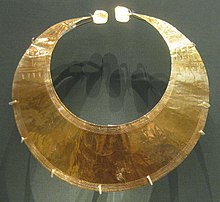

Gold working in the Bronze Age British Isles refers to the use of gold to produce ornaments and other prestige items in the British Isles during the Bronze Age, between c. 2500 and c. 800 BCE in Britain, and up to about 550 BCE in Ireland. In this period, communities in Britain and Ireland first learned how to work metal, leading to the widespread creation of not only gold but also copper and bronze items as well. Gold artefacts in particular were prestige items used to designate the high status of those individuals who wore, or were buried with them.
Around 1,500 gold objects dating to the Bronze Age survive in collections, around 1000 of them from Ireland and the other 500 from Britain; this is a much smaller number than would have been originally crafted, leading archaeologists to believe that "many thousands of gold objects were made and used" in the Bronze Age British Isles.[1]
Records indicate that Bronze Age gold artefacts had begun to be discovered by the 18th century at the least, although at the time many were melted down or lost. Only with the rise of the antiquarian and then archaeological movements were the antiquity of these items recognised, after which they were more usually preserved in collections. The archaeologist George Eogan noted that investigation of Bronze Age gold artefacts revealed not only "the work of craftsmen and technicians" from that period but also aided our understanding of "broader aspects of society such as social stratification, trade, commerce and ritual."[1]